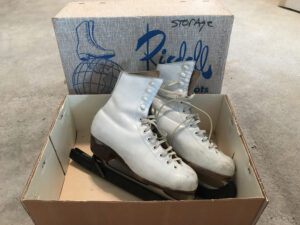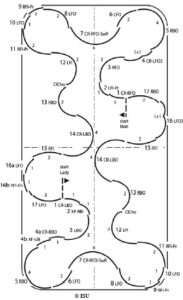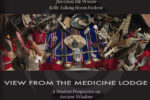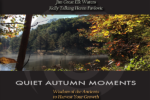The Five Faces of Discipline

The bedroom was always completely dark. I shared it with my mom while growing up in the tiny (800 sq ft) home of my grandparents. And my twin bed was so warm and cozy in the dead of winter. With not much insulation in the walls, our second floor room could get pretty chilly. But the bed… the bed was so toasty with the electric blanket I was so fortunate to have.
Nonetheless, three times a week either my mom or my aunt Marlene would come to roust me out of my deep slumber at 4:30 in the morning. Oh, how I did not want to leave that bed. Especially on those cold winter mornings.
I have never been a “morning person.” Even at that young age. And it certainly wasn’t because I was coddled about it. Nope. Those mornings I was expected to be up and out of bed, regardless of how my brain desperately tried to resist.
The reason for the rousting? Figure skating practice at an ice rink 30 minutes away from our house.
From the age of 4 until I was almost 13, I figure skated all four seasons of every year. I had two great coaches over that time – champions both in their own disciplines. The rinks I went to for practice in northern Ohio ranged from Euclid to Shaker Heights, Kent to Hudson. Mom and Marlene did a lot of driving for my sake.
It was during those times of…unpleasantries, that I learned discipline includes doing things you don’t necessarily want to do…
All that meant that on those early morning practice days, I had to wake, get down the narrow stairway without breaking my neck – as I was always half asleep – and then sit at the kitchen table like a zombie trying to eat and/or drink something. Ugh.
After that would be dressing for skating (including the dreaded tights… unless I was lucky enough to get away with “warm-up” pants that day), and packing school clothes to change into later. After practice we had just enough time to get back to our side of town and for me to get to school, and mom or Marlene to get to work.
It was during those times of, what I considered to be, such unpleasantries, that I learned discipline includes doing things you don’t necessarily want to do… For the sake of the desired outcome. For me it has always been jarring to be startled out of sleep. I don’t like it. Probably no less than most but still… I don’t like it. Even to this day, I try to find ingenious ways of getting myself awake as gently as possible. (I love the new Bedtime function on my iPhone, the alarm tones are so much more civilized than others!) But as a child, I knew that to improve my skating skills, I had to be up and awake and in the car by a certain hour. No lallygagging. And so, it was part of the package I must accept. Even if I nearly sleepwalked through the part between bed and car. Therefore I learned to endure the “yucky parts” with the knowledge of the purpose for doing so.
Part of figure skating back in the 70s – actually for the first 50 years of it being a competitive sport – was something called “Compulsory Figures.” It’s a very odd concept and practice to explain if you’ve never been around a skater because it has not been shown widely on televised Olympic Games. Wikipedia sums it up as, “Compulsory figures, also called school figures, are the ‘circular patterns which skaters trace on the ice to demonstrate skill in placing clean turns evenly on round circles.’ Compulsory figures are also called ‘patch,’ a reference to the patch of ice allocated to each skater to practice figures. Figure skating historian James Hines reported that compulsory figures were ‘viewed as a means of developing technique necessary for elite skaters.’” Here’s an excellent YouTube video that gives you the feel for it in a quick three minute shot.
Those compulsory figures taught me that discipline includes the mastery of focus.
These figures were practiced and practiced repeatedly until you could perform them with such precision that your traces (lines from your blades left on the ice) would practically disappear on top of one another. It was very quiet time in the rink during “Patch.” I suppose now I might consider it to be meditative time but back then… it was nerve-wracking to develop the whole-body motor skills required to reliably duplicate shape, size, and transitions every single repetition. These sessions would typically last for about an hour. And, as the name says, it was compulsory for freeskating at the time.
They were part of a testing system that was done as USFSA’s proficiency requirements (that is, the United States Figure Skating Association). Every line, every turn, every transition, was scrutinized during these eyes-on testing sessions, by three judges bundled up far warmer than the skater, and never wearing skates themselves… always boots. It was an interesting experience.
Those compulsory figures taught me that discipline includes the mastery of focus. I understood the parameters of how I would be judged. To become proficient at this type of body control – which was essentially the root of it all – it required absolute concentration. The rink was always completely silent during these times. No one spoke except when they had a coach with them, and this was long before the time of iPods or iPhones… not even walkmans had been brought to market yet.
Tracing those lines over and over and over again required mental fortitude beyond what many of us do on a daily basis. And, quite honestly, I believe it was the single most beneficial thing I learned during those years of practice. Sure, I intensely disliked how incredibly picky everyone (coach and judges) were, how precisely the figures had to be. In fact, during practice we used something called a “scribe” to trace a pattern onto the ice. Today it would be called a “cheat.” But it helped us to follow the prescribed figure while our body learned the muscle memory it required to simply step out onto the ice and consistently create circle eights or even serpentines which consisted of three circles of matching diameters.
Yup, lots of concentration and focus. But, not unsurprisingly, it spilled over into other parts of my life – then, later in my teen years, and even today. In school I was more able to concentrate and settle myself than anyone else in my classes. And later when I moved into music, specifically being a flutist, it came in handy to have the ability to focus on the lines of little black dots in front of me (sheet music). Today, I still use that long ago mastered skill of focus during my Mide’ study, ritual, and meditation.
The longer I skated, and the more I did three of the four disciplines of figure skating – compulsory figures, singles free skating, and dance – I learned that ice dancing was where my interest and passion truly lay. I loved it. I loved the music. And I loved the ability to glide along, slow, fast, short steps, long sweeping strokes… It resonated with me even at that young age. And so I eventually chose to drop the free skating (which also required those damnable Compulsory Figures, as dance did not) because I seemed to have a more natural propensity for keeping my skates on the ice, as opposed to spinning and jumping.

From my very first dance lesson – which I remember as clearly as if I’d done it yesterday – was the Dutch waltz. It was the first dance in the Preliminary level group of dances you must master to be granted that medal from the USFSA. In that evening, I learned that ice dancing was a complex activity. You must memorize the dance steps to every single dance you intend to skate, and the pattern they necessarily trace across the entirety of the ice rink. Women’s steps were often different from men’s steps so they would come together as a couple smoothly sweeping across the ice.
…how you do things is as important as actually doing them.
There are steps to both learn how to do and what they are called – things like mohawk, chasse, choctaw, swing, progressive, and more. And, like Compulsory Figures, the steps you do for the prescribed dance, must create a pattern on the ice per the official USFSA guide book. And the dances are grouped, by difficulty, into eight groups from Preliminary to International.
My absolute favorite to watch and to dance was the Pre-Gold dance called the Blues. It must be where I learned that I loved blues music also. The steps are seductive and sweeping… and oh so much fun to skate!
In ice dancing, I learned about the facet of discipline that is process. Oxford Dictionary defines process as “a series of actions or steps taken in order to achieve a particular end.” In other words, how you do things is as important as actually doing them. There is process to any successful organization or individual.
In this particular example, I learned not only the steps themselves, but the process of how they were strung together, in what order, to achieve the perfection of the dance itself. I learned what tempo and style music to which each dance was skated – for a waltz must be in 3/4 time, and each waltz even had its required tempo, be it fast or slow. The beginner Dutch waltz was much slower, say, that the more advanced Starlight waltz
The way we do things sets up a pattern for an outcome. This is similar to what I’ve been telling my audiences for years: You can’t get to your destination if you don’t know where it is. Once the goal, the outcome, has been defined, you can then develop the process for achieving it, for reaching it.
Process is a critical aspect of discipline. Without having set and repeatable steps for accomplishing an end goal, it is not reliably repeated – by you, or any team, or group of people.
I’ve explained the way testing was done in Compulsory Figures. There was also testing for ice dance. Dances were always done with a partner, and if you had been practicing and perfecting solo, adding the second part in was always interesting. During a test I was the only one being judged but it wasn’t just steps and precision. It was also about my interaction with my partner, how I held a pose, how closely we held the pose together, and whether or not, bluntly put, it appeared that I was keeping up with him in speed and strength. No dragging the testing student along for the ride.
If you forget why you are doing something, it makes less sense to continue doing it.
When you felt you were good enough to do a dance in front of judges, and to their standards, then practicing with the partner began. It was always necessary to be sure my partner for testing would be more advanced than I. And so began the next phase of perfecting my performance on any dance I wanted to “test.”
The entire string of events of first learning the steps/pattern all the way to being ready to step out onto the ice and be judged, literally, kept me committed to a singular goal: “Do it well enough that three judges would agree and ‘pass’ me,” allowing me to move up to the next level of achievement where the process started all over again with new dances.
This repetition of learn, practice, test really fostered an achievement mentality. When you are disciplined, you keep the end goal in mind. Always. Every time I showed up at the rink for practice, I had an end goal in mind. Every step I perfected, every push with a blade that made me cover more ice more quickly, every repetition of the pattern.
“Never take your eyes off the prize,” as the saying goes. If you forget why you are doing something, it makes less sense to continue doing it. The human psyche searches for reason(s).
Without the achievement mentality, it makes little sense to continue. With discipline comes reaching your goals.
When I first began to skate at the age of four – I remember it also like yesterday – it was so foreign to my little immature brain. And yet, that “little immature brain” was exactly how I was able to go out and do what I did… which was strapping onto my little feet, two very rigid leather boots to which were attached each a very narrow steel blade – about 1/4” thick to be exact. Once they were on, I had to walk in them – wobbling and ankle bending the whole way to the rink itself. Once there, I had to have courage to step those thin blades out onto a huge sheet of ice… and somehow stay upright.
The more discipline I had in continuing to practice, even when it was scary or uncomfortable, I began to develop self-confidence.
Those first few times it was honestly difficult to get me to let go of the sideboards. I had a death grip as my ankle wobbled and those blades would slip forward with no help from me to either begin it or stop it. Even to a little kid who has no real concept of being anything less than immortal, it was a very scary proposition. Getting my blades securely under me, and my leg muscles to learn how to control the movement was an experience.
Slowly I learned how to be confident in being on the ice in skates. And after that, like after the first baby steps on land, I was off to the races. I wanted to learn what else I could do with this new found ability.
The more discipline I had in continuing to practice, even when it was scary or uncomfortable, I began to develop self-confidence. The more goals I achieved, the more comfortable and confident in myself I became.
This is true for any hobby, profession, or sport. The more you do, the more you learn. The more you learn, the better you get. The better you get, the more confident you become in your own abilities. And that, in turn, leads most of us to want to keep repeating the process, and learning more.
Unpleasantness :: Focus :: Process :: Achievement Mentality :: Self-Confidence
The Five Faces of Discipline are a path that leads you from the unpleasant to the confidence in yourself to achieve even more.In the face of unpleasantness or even fear, we develop focus and concentration to begin perfecting the task at hand. The focus then leads to the awareness of process and that how we do things matters. Working through the process gives us an achievement mentality, and commitment to the goal. As goals become attainable and actually reached, our self-confidence levels rise and we begin to see ourselves as better than we were when we began.
I hope my memories of lessons learned in the ice rinks in 1970’s Ohio will inspire you to look at discipline with more detail. The next time you want to achieve something, keep the Five Face of Discipline in mind.
Always wishing you the best of everything, success beyond your wildest dreams, and the satisfaction that comes from a life lived in balance. Be well…
kvp:2521
Look for books from the WeWan on Amazon:





